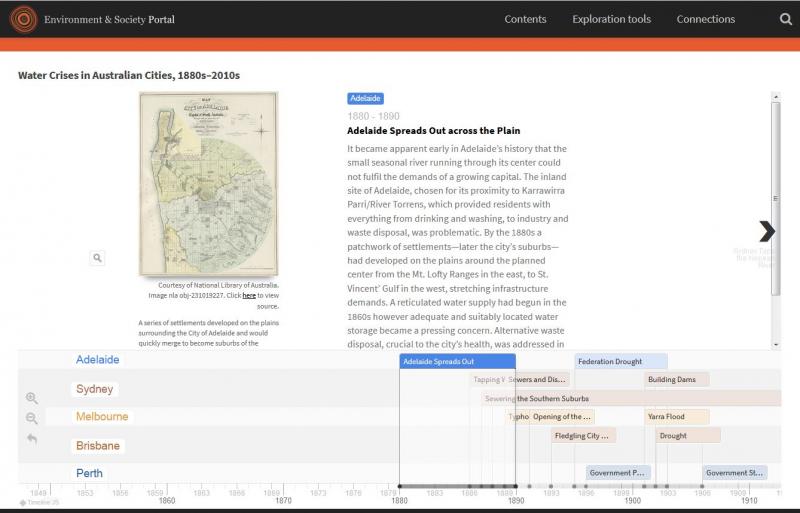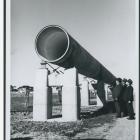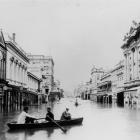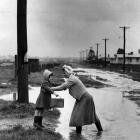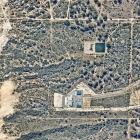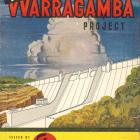floods
How a Catastrophic Flood of the Gürbe River Triggered the Rethinking of Local Flood Protection
Australian Cities Timeline
Drought, Mud, Filth, and Flood: Water Crises in Australian Cities, 1880s–2010s
In this exhibition, we invite visitors to consider the historical relationship of “water crises” of various kinds to the development of urban water systems, through the experience of the driest inhabited continent on earth, Australia. We have chosen a range of different departures from water-related business as usual—from shortage to flood, pollution to drainage—in the five mainland Australian state capitals from the late nineteenth century to the present. The part of this exhibition devoted to each city focuses thematically on just one or two kinds of crisis, while the timeline covers a wider range of events in each place.
About the ExhibitionAbout the author

University of Western Australia
Show more
University of Queensland & La Trobe University, Australia
Show more
Monash University, Australia
Show more
University of Western Australia
Show more
Monash University, Australia
Show more
University of South Australia
Show more
University of Queensland, Australia
Show more
University of South Australia
Show more
University of Sydney, Australia
Show more
University of Western Australia
Show more
University of Western Australia
Show moreBrowse the exhibition
Sydney: Dam Water, Filth to the Ocean
Sydney: Dam Water, Filth to the Ocean
In this chapter of the virtual exhibition “Drought, Mud, Filth, and Flood: Water Crises in Australian Cities, 1880s–2010s,” the authors describe how the city of Sydney, New South Wales, has pursued the dual goals of plentiful water and cheap sanitation through the construction of the massive Warragamba Dam and ocean outfall sewers. Sewage polluting Sydney’s iconic beaches saw large protests in the 1980s and 1990s and closer monitoring of the ocean outfalls. Householders successfully curtailed their water consumption during the Millennium Drought, but as soon as dam levels rose again, water restrictions were abandoned because water retailers gain financially from higher consumption.
Drought, Mud, Filth, and Flood: Water Crises in Australian Cities, 1880s–2010s
In this exhibition, we invite visitors to consider the historical relationship of “water crises” of various kinds to the development of urban water systems, through the experience of the driest inhabited continent on earth, Australia. We have chosen a range of different departures from water-related business as usual—from shortage to flood, pollution to drainage—in the five mainland Australian state capitals from the late nineteenth century to the present. The part of this exhibition devoted to each city focuses thematically on just one or two kinds of crisis, while the timeline covers a wider range of events in each place.
About the ExhibitionAbout the author

University of Western Australia
Show more
University of Queensland & La Trobe University, Australia
Show more
Monash University, Australia
Show more
University of Western Australia
Show more
Monash University, Australia
Show more
University of South Australia
Show more
University of Queensland, Australia
Show more
University of South Australia
Show more
University of Sydney, Australia
Show more
University of Western Australia
Show more
University of Western Australia
Show moreBrowse the exhibition
Perth: Water Beneath the City
Perth: Water Beneath the City
In this chapter of the virtual exhibition “Drought, Mud, Filth, and Flood: Water Crises in Australian Cities, 1880s–2010s,” the authors show the extent to which the people of Perth, Western Australia, have relied on the groundwater of the Swan Coastal Plain, and the implications of this reliance in a drying climate. In the context of private and public extraction of groundwater, the government in 2014 commenced a groundwater replenishment scheme to “recharge” the local aquifers with treated wastewater.
Drought, Mud, Filth, and Flood: Water Crises in Australian Cities, 1880s–2010s
In this exhibition, we invite visitors to consider the historical relationship of “water crises” of various kinds to the development of urban water systems, through the experience of the driest inhabited continent on earth, Australia. We have chosen a range of different departures from water-related business as usual—from shortage to flood, pollution to drainage—in the five mainland Australian state capitals from the late nineteenth century to the present. The part of this exhibition devoted to each city focuses thematically on just one or two kinds of crisis, while the timeline covers a wider range of events in each place.
About the ExhibitionAbout the author

University of Western Australia
Show more
University of Queensland & La Trobe University, Australia
Show more
Monash University, Australia
Show more
University of Western Australia
Show more
Monash University, Australia
Show more
University of South Australia
Show more
University of Queensland, Australia
Show more
University of South Australia
Show more
University of Sydney, Australia
Show more
University of Western Australia
Show more
University of Western Australia
Show moreBrowse the exhibition
Melbourne: DIY Infrastructure
Melbourne: DIY Infrastructure
In this chapter of the virtual exhibition “Drought, Mud, Filth, and Flood: Water Crises in Australian Cities, 1880s–2010s,” the authors describe the ways in which infrastructure failed to keep pace with population growth in Melbourne, Victoria, and how residents developed their own means to overcome deficiencies. Residents of the postwar suburban frontier installed septic tanks and pan toilets, joined together to lay stormwater drains to improve the health and amenity of their local streets.
Drought, Mud, Filth, and Flood: Water Crises in Australian Cities, 1880s–2010s
In this exhibition, we invite visitors to consider the historical relationship of “water crises” of various kinds to the development of urban water systems, through the experience of the driest inhabited continent on earth, Australia. We have chosen a range of different departures from water-related business as usual—from shortage to flood, pollution to drainage—in the five mainland Australian state capitals from the late nineteenth century to the present. The part of this exhibition devoted to each city focuses thematically on just one or two kinds of crisis, while the timeline covers a wider range of events in each place.
About the ExhibitionAbout the author

University of Western Australia
Show more
University of Queensland & La Trobe University, Australia
Show more
Monash University, Australia
Show more
University of Western Australia
Show more
Monash University, Australia
Show more
University of South Australia
Show more
University of Queensland, Australia
Show more
University of South Australia
Show more
University of Sydney, Australia
Show more
University of Western Australia
Show more
University of Western Australia
Show moreBrowse the exhibition
Introduction
Introduction
This is the introductory page of the virtual exhibition “Drought, Mud, Filth, and Flood: Water Crises in Australian Cities, 1880s–2010s”—written and curated by Andrea Gaynor et al.
Drought, Mud, Filth, and Flood: Water Crises in Australian Cities, 1880s–2010s
In this exhibition, we invite visitors to consider the historical relationship of “water crises” of various kinds to the development of urban water systems, through the experience of the driest inhabited continent on earth, Australia. We have chosen a range of different departures from water-related business as usual—from shortage to flood, pollution to drainage—in the five mainland Australian state capitals from the late nineteenth century to the present. The part of this exhibition devoted to each city focuses thematically on just one or two kinds of crisis, while the timeline covers a wider range of events in each place.
About the ExhibitionAbout the author

University of Western Australia
Show more
University of Queensland & La Trobe University, Australia
Show more
Monash University, Australia
Show more
University of Western Australia
Show more
Monash University, Australia
Show more
University of South Australia
Show more
University of Queensland, Australia
Show more
University of South Australia
Show more
University of Sydney, Australia
Show more
University of Western Australia
Show more
University of Western Australia
Show moreBrowse the exhibition
Adelaide: Restricted Development
Adelaide: Restricted Development
In this chapter of the virtual exhibition “Drought, Mud, Filth, and Flood: Water Crises in Australian Cities, 1880s–2010s,” the authors describe how the city of Adelaide has responded to periodic water shortages. Water security was sought first in reservoirs, then the Murray River, and more recently desalination. While earlier periods of shortage led to the development of the dual-flush toilet, the need for water conservation was only really cemented in the urban consciousness with the Millennium drought of 1996–2010.
Drought, Mud, Filth, and Flood: Water Crises in Australian Cities, 1880s–2010s
In this exhibition, we invite visitors to consider the historical relationship of “water crises” of various kinds to the development of urban water systems, through the experience of the driest inhabited continent on earth, Australia. We have chosen a range of different departures from water-related business as usual—from shortage to flood, pollution to drainage—in the five mainland Australian state capitals from the late nineteenth century to the present. The part of this exhibition devoted to each city focuses thematically on just one or two kinds of crisis, while the timeline covers a wider range of events in each place.
About the ExhibitionAbout the author

University of Western Australia
Show more
University of Queensland & La Trobe University, Australia
Show more
Monash University, Australia
Show more
University of Western Australia
Show more
Monash University, Australia
Show more
University of South Australia
Show more
University of Queensland, Australia
Show more
University of South Australia
Show more
University of Sydney, Australia
Show more
University of Western Australia
Show more
University of Western Australia
Show moreBrowse the exhibition
Brisbane: Dams and the Subtropical Challenge
Brisbane: Dams and the Subtropical Challenge
In this chapter of the virtual exhibition “Drought, Mud, Filth, and Flood: Water Crises in Australian Cities, 1880s–2010s,” the authors show how the development of Brisbane, Queensland, on a floodplain rendered the city vulnerable to flood events. Although engineering measures have mitigated floods, this overview highlights the enduring belief in urban “flood-proofing” alongside evidence that it cannot ever be achieved in this context.
Drought, Mud, Filth, and Flood: Water Crises in Australian Cities, 1880s–2010s
In this exhibition, we invite visitors to consider the historical relationship of “water crises” of various kinds to the development of urban water systems, through the experience of the driest inhabited continent on earth, Australia. We have chosen a range of different departures from water-related business as usual—from shortage to flood, pollution to drainage—in the five mainland Australian state capitals from the late nineteenth century to the present. The part of this exhibition devoted to each city focuses thematically on just one or two kinds of crisis, while the timeline covers a wider range of events in each place.
About the ExhibitionAbout the author

University of Western Australia
Show more
University of Queensland & La Trobe University, Australia
Show more
Monash University, Australia
Show more
University of Western Australia
Show more
Monash University, Australia
Show more
University of South Australia
Show more
University of Queensland, Australia
Show more
University of South Australia
Show more
University of Sydney, Australia
Show more
University of Western Australia
Show more
University of Western Australia
Show moreBrowse the exhibition
Further Reading
Further Reading
Adelaide
Drought, Mud, Filth, and Flood: Water Crises in Australian Cities, 1880s–2010s
In this exhibition, we invite visitors to consider the historical relationship of “water crises” of various kinds to the development of urban water systems, through the experience of the driest inhabited continent on earth, Australia. We have chosen a range of different departures from water-related business as usual—from shortage to flood, pollution to drainage—in the five mainland Australian state capitals from the late nineteenth century to the present. The part of this exhibition devoted to each city focuses thematically on just one or two kinds of crisis, while the timeline covers a wider range of events in each place.
About the ExhibitionAbout the author

University of Western Australia
Show more
University of Queensland & La Trobe University, Australia
Show more
Monash University, Australia
Show more
University of Western Australia
Show more
Monash University, Australia
Show more
University of South Australia
Show more
University of Queensland, Australia
Show more
University of South Australia
Show more
University of Sydney, Australia
Show more
University of Western Australia
Show more
University of Western Australia
Show more

